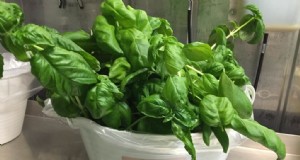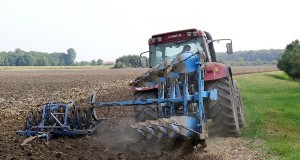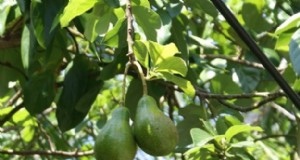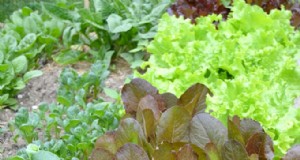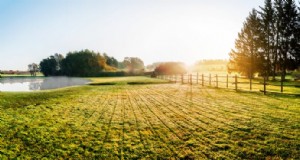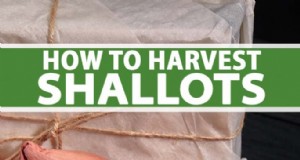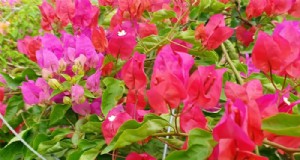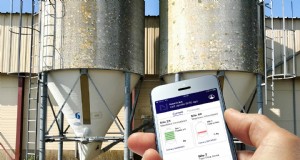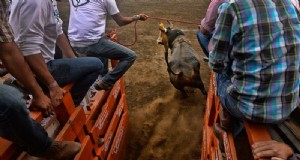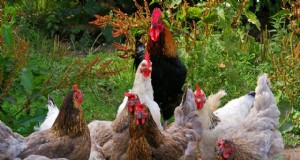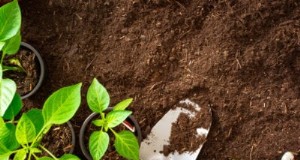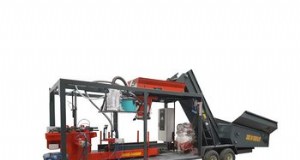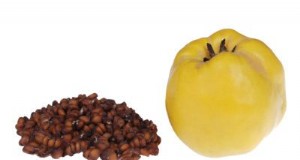KOLAM S
Di alam, banyak ikan tidak pernah mencapai ukuran dewasa karena dimakan oleh hewan lain atau predator atau mati karena penyakit atau kekurangan oksigen. Budidaya ikan di tambak mencoba mengendalikan situasi agar menghasilkan lebih banyak ikan. Di kolam pemangsa dapat dikendalikan sehingga kolam menghasilkan lebih banyak ikan daripada perairan alami. Pertumbuhan ikan di kolam terutama disebabkan oleh fakta bahwa ikan tidak dapat melarikan diri, dan memberi makan, pembiakan, budidaya dan panen ikan dilakukan secara terencana.
Budidaya ikan dilakukan di kolam. Ini adalah badan air dangkal kecil dalam kondisi alami dan benar-benar dapat dikeringkan, biasanya dibangun secara artifisial. Kolam alami berbeda dari danau karena memiliki zona litoral yang relatif besar dan zona profundal yang kecil. Sumber air mereka juga dapat bervariasi.
H ist Hai R kamu
Menanam ikan di kolam adalah praktik yang sangat kuno. Ikan dibudidayakan sejak 2698 SM. Di Tiongkok. Budidaya ikan tampaknya terjadi setiap kali peradaban menetap untuk jangka waktu yang lama. Budidaya ikan dilakukan di Mesir kuno dan di Cina, yang telah memiliki peradaban berkelanjutan selama lebih dari 4000 tahun. Catatan tertulis pertama tentang budidaya ikan di kolam adalah oleh Fan Lai, seorang petani ikan Cina pada 475 SM. Bangsa Romawi kuno memperkenalkan ikan mas dari Asia ke Yunani dan Italia. Menjelang abad ketujuh belas, budaya ikan mas sedang dipraktekkan di seluruh Eropa.
W H kamu fi S H gr Hai w Saya n po n D S
Praktek budidaya ikan di kolam lebih menguntungkan. Lebih mudah menangkap ikan dari kolam daripada menangkapnya dari sumber daya alam. Pertumbuhan ikan dapat dikendalikan. Ikan dapat diberi makan makanan tambahan untuk meningkatkan nilai pasarnya. Musuh alami dapat dijauhkan dari membunuh ikan di kolam. Ikan dapat terhindar dari penyakit. Di kolam, produksi ikan dapat ditingkatkan dengan manajemen ilmiah dan lebih banyak pendapatan dapat dihasilkan. Budidaya ikan dapat membantu petani memanfaatkan lahan dengan sebaik-baiknya. Mengipasi ikan juga bisa memberikan penghasilan tambahan.
T kamu pe S Hai F fis H tanah pertanian S
Ada dua jenis utama budidaya ikan terutama berdasarkan sifat pemeliharaan.
1. Peternakan ikan di mana ikan dibesarkan untuk memelihara benih dan benih.
2. Peternakan ikan di mana benih atau benih dibesarkan dengan ukuran yang dapat dipasarkan. Petani harus memutuskan jenis budidaya ikan apa yang akan dia mulai.
B A S e D Hai n apa e R sup P aku kamu T Hai poni D S , T H e kamu ar e kelas S si F yaitu D Saya n T Hai 5 T kamu pe S .
S pri n G wa te R P ondo S :Kolam mata air disuplai oleh air tanah, baik melalui mata air alami di dasarnya atau melalui mata air lain yang terletak di sebelahnya. Mata airnya bagus untuk budidaya ikan karena bersih dan tidak ada ikan atau telur ikan yang tidak diinginkan di dalamnya. Jika mata air telah menempuh jarak yang jauh sebelum mengalir ke kolam, mungkin mengandung kontaminan dan harus disaring sebelum digunakan.
R A Saya n wa te R P Hai n D S :Ini juga disebut sebagai kolam langit. Ini diisi dengan air hujan dan tingkat pengisiannya tergantung pada jumlah curah hujan.
W e aku aku w A te R poni D S : Ini diisi dengan air sumur dan dianggap sangat baik untuk budidaya ikan. Mereka mungkin cukup disuplai dengan air yang tidak memiliki kontaminan.
F aku Hai Hai D tolong A Saya n sapi - B Hai w P pada D S :Air untuk kolam ini disuplai oleh sungai. Ini sangat produktif karena akumulasi bahan organik dan banjir berkala.
W pada e R C ou R S e P pada D S : Kolam ini ditempatkan pada aliran air yang mengalir dan dibagi lagi menjadi dua jenis utama.
B A se D Hai n w A T e R S kamu ppl kamu , S Hai Saya aku A n D T Hai P ogra P H kamu T H e P Hai dan S ar e Hai f lima jenis.
Banyak aspek dari konstruksi kolam ini yang sama. Perbedaan utama antara ini adalah sumber air. Ini adalah:
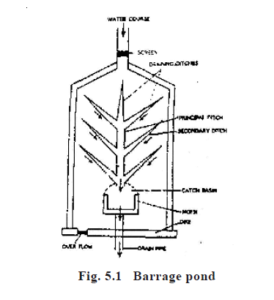
B A R ra G e P pada D S : Kolam-kolam ini biasanya diisi oleh air hujan atau mata air. Musim semi, Misalnya, mengirimkan air yang mengalir melalui lembah kecil atau menuruni lereng ke tempat yang rendah. Atau, sebuah gelembung pegas dari tanah menjadi depresi alami. Kolam terbentuk dengan mengumpulkan air di dasar lembah dan di tempat yang rendah. Petani melakukan ini dengan membangun dinding atau bendungan yang menahan air di dalamnya, apa sekarang, adalah area tambak. Jumlah dinding kolam yang harus dibangun tergantung pada lahan dan sistem drainase. Sebuah kolam bendungan biasanya hanya membutuhkan satu dinding – dinding utama antara sumber air dan area kolam.
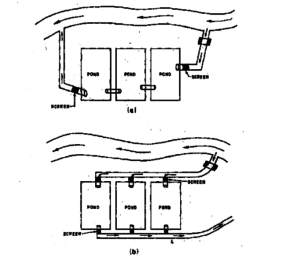
D ivers Saya Hai n kolam S A ) Ro S ar kamu sistem M B ) P aralle aku S kamu ste M
Salah satu sistem drainase yang disebut sluice cart digunakan untuk mengalirkan air baik keluar maupun masuk kolam. Ada juga sejumlah sistem drainase sederhana yang dapat digunakan yang tidak memerlukan konstruksi yang rumit.
Kolam bendungan (Gbr. 5.1) tidak boleh dibangun di mana aliran air terlalu besar karena sulit untuk menahan air agar tidak meruntuhkan dinding jika tekanan air terlalu besar. Anak sungai dan sungai yang mengalir dengan baik, tapi tidak terlalu kuat, membuat sumber yang baik untuk kolam rentetan.
Bahkan ketika aliran air tidak besar, Namun, kolam bendungan membutuhkan saluran pelimpah. Karena kolam bendungan biasanya dibangun di daerah rendah, mereka cenderung terisi selama hujan lebat. Saluran luapan merupakan jenis sistem apa pun yang dapat diatur untuk menghentikan kolam agar tidak mengumpulkan terlalu banyak air. Luapan mengambil air ekstra dari kolam. Jika air ekstra ini tidak dikuras, dinding kolam bisa pecah.
D saya R sio n poni D S :
Kolam ini dibuat dengan mengalihkan air dari sumber lain seperti sungai atau sungai. Saluran digali untuk mengalirkan air dari sumber air ke kolam. Kolam pengalihan dapat dibuat dengan beberapa cara. Kadang-kadang kolam digali di tanah datar atau dapat dibuat dengan sedikit memperbesar cekungan alami di tanah. Kolam ini membutuhkan dinding tergantung pada topografi tanah, sistem drainase, dll.
Di kolam pengalihan (Gbr. 6.2), air selalu dibawa ke kolam melalui saluran pengalihan alih-alih mengalir langsung ke kolam. Air dapat dialihkan dengan beberapa cara. Sebuah sungai kecil yang mendapatkan airnya dari sungai yang lebih besar di dekatnya dapat dibendung dan digunakan sebagai saluran pengalihan untuk memberi makan kolam. Kolam pengalihan dapat dibangun dengan dua cara.
R osar kamu sy S te M :
Kolam-kolam ini dibangun satu demi satu dalam sebuah tali. Semua kolam mengalir ke satu sama lain dan harus dikelola seolah-olah mereka adalah satu kolam. Jika kolam pertama dalam seri dengan saluran masuk air penuh dengan predator yang harus diracuni, semua kolam lainnya harus dipanen dan dikeringkan sebelum kolam pertama bisa diracuni.
P aralle aku sistem :
Setiap kolam memiliki saluran masuk dan saluran keluarnya sendiri. Karena itu, setiap kolam dapat dikelola sebagai kolam terpisah. Sistem paralel adalah sistem yang lebih baik. Tetapi sistem rosario lebih murah dan lebih mudah untuk dibangun. Jika sumber airnya bagus, dan dapat dijaga bebas dari predator, dan jika pengelolaan tambak dilakukan dengan baik, ini adalah sistem yang lebih murah dan lebih baik.
Kolam pengalihan selalu lebih baik daripada kolam rentetan. Hal ini disebabkan oleh fakta bahwa mereka cenderung tidak meluap dan sumber air lebih dapat diandalkan sepanjang tahun. Kolam bendungan, Namun, membutuhkan lebih sedikit konstruksi dan cenderung lebih murah.
P ondo S M A kamu Al S Hai B e C lalu S ifie D A C C ordin G T Hai th ei R S iz e NS D kamu melengkung e di dalam A ikan tanah pertanian ke dalam lima jenis
Ini dibangun sesuai dengan kebutuhan ikan atau tahapan siklus hidupnya. Ini adalah:
H ea D po n D :Kolam ini biasanya dibangun di dekat sumber air abadi. Tujuan utama dari kolam adalah untuk memenuhi kebutuhan air seluruh peternakan, dengan mempertimbangkan kerugian melalui rembesan, penguapan dll.
H pada C Hai n G P pada D S :Ini juga disebut sebagai kolam pemijahan. Ini kecil dan sebagian besar dalam bentuk tangki kecil atau kolam plastik, dibuat di dekat pusat pengumpulan bibit. Hapas dipasang di kolam ini. Telur dikumpulkan dan disimpan di hapas untuk ditetaskan. Kolam serupa juga dibangun di peternakan ikan. Ini sedikit lebih dalam dengan sirkulasi air. Disini juga, hapa dipasang di dalam kolam. Induk dilepaskan ke hapa setelah memberi mereka suntikan hormonal. Pemijahan terjadi di dalam hapa dan telur juga dibiarkan menetas di sini.
n kami e R kamu P ondo S :Ini juga disebut kolam transplantasi. Ini adalah kolam musiman dan dibangun di dekat kolam pemijahan dan pemeliharaan. Tujuan utamanya adalah untuk menciptakan kondisi ketersediaan makanan dan pertumbuhan benih yang sesuai karena pada tahap ini mereka paling rentan terhadap bahaya seperti aksi gelombang dan predator. Ini harus berupa kolam kecil dan dangkal 0,02-0,06 ha. dalam ukuran dan 1-1,5 m. secara mendalam. Di pembibitan, bibit (5-6 mm) dipelihara sampai tahap benih (25-30 mm) selama kurang lebih 15 hari. Kolam ini biasanya berbentuk persegi panjang. Perhatian ekstra harus diambil untuk membesarkan tahap muda, jika tidak, kematian berat dapat terjadi. Terkadang bibit dikultur selama 30 hari juga. Dasar kolam harus miring ke arah outlet untuk memudahkan pengoperasian jaring. Pembibitan kecil dan musiman lebih disukai karena membantu mengendalikan kondisi lingkungan secara efektif. Dalam prakteknya sekitar 10 juta bibit per hektar ditebar di kolam pembibitan.
R telinga Saya n G po n D S :Ini harus sedikit lebih besar tetapi tidak proporsional dalam. Ini harus ditempatkan di dekat kolam pembibitan dan jumlahnya dapat bervariasi tergantung pada budaya. Mereka sebaiknya berukuran 0,08-0,10 ha dan kedalaman 1,5-2,0 m. Benih (25-30 mm) dipelihara di sini sampai tahap benih (100-150 mm) selama sekitar 3-4 bulan. Benih ikan mas yang ditanam di kolam pembibitan berukuran relatif kecil dan tidak cukup layak untuk dipindahkan langsung ke kolam penebaran. Di kolam penebaran ikan yang lebih besar mungkin ada yang mungkin memangsa benih. Karenanya, sangat diinginkan untuk menumbuhkan benih di kolam pemeliharaan di bawah praktik manajemen yang tepat hingga ukuran benih sehingga kemampuan mereka untuk menahan predasi akan ditingkatkan.
S ke kin G kolam :Ini adalah kolam terbesar dan lebih dalam, dengan kedalaman sekitar 2-2,5 m. Ukuran kolam dapat bervariasi dari 0,2-2,0 ha., tetapi ini sebaiknya berukuran 0,4-0,5 ha. Ini berbentuk persegi panjang. Bibit dan bibit lanjutan dipelihara hingga ukuran yang dapat dipasarkan selama sekitar 6 bulan. Ikan berumur satu tahun bisa tumbuh hingga 1 kg. atau lebih berat.
Perawat kamu po n D :
Pengelolaan kolam pembibitan merupakan salah satu aspek terpenting untuk keberhasilan praktik budidaya ikan. Penetasan atau pemijahan dipelihara untuk tahap menggoreng di kolam kecil yang disebut kolam pembibitan. tukik, bertelur dan menggoreng sangat halus, ini harus, karena itu, dipelihara dengan sangat hati-hati untuk mendapatkan tingkat kelangsungan hidup yang sangat baik.
Manajemen pembibitan harus dimulai sejak musim panas, sehingga dapat menghasilkan benih yang baik. Pengeringan kolam pembibitan di musim panas membantu mineralisasi, penghapusan detritus organik dan penghancuran predator dan gulma air, yang lebih banyak di pembibitan abadi. Kolam harus dikosongkan, tetapi lapisan-lapisan halus dari tanah tandus yang mengandung matriks humus yang kaya dapat digunakan untuk mengisi sisi atau pematang yang terkikis di dalam kolam pembibitan. Ini membantu dalam nilai manurial dari lapisan permukaan bumi yang kaya dan menambah produktivitas kolam. Outlet, saluran masuk dan penguatan pematang juga harus diperhatikan selama musim panas. Vegetasi di pematang merupakan tempat berkembang biak yang sangat baik bagi serangga, karenanya, ini harus dihancurkan dan vegetasi dibakar selama musim panas.
Jika pengeringan kolam tidak memungkinkan, lebih baik masuk untuk meracuni kolam. Racun seperti endrin, tafadrin, bubuk akar derris dan kue minyak Mohua digunakan untuk membasmi musuh ikan. Untuk pengelolaan kolam pembibitan yang sukses, teknik pengelolaan sebelum dan sesudah tebar berikut harus diikuti.
Pra - berhenti C kerabat G poni D M ana G em n T
Ini melibatkan pemilihan lokasi, pemberantasan gulma, serangga dan predator, pengapuran, pemupukan, dll.
G ulang e n ibu n kamu Saya n G Saya n th e P pada D :
Tumbuhnya tanaman di dasar kolam merupakan kebutuhan untuk menyuburkan tanah. Proses ini dikenal sebagai pemupukan hijau. Tanaman jangka pendek dari anggota keluarga kacang-kacangan seperti kacang polong, kacang polong, dll membantu dalam pengayaan tanah dengan nitrogen. Setelah pertumbuhan tanaman, dasar kolam dibajak dan diratakan dengan akar tanaman di dalam tanah. Bintil akar tanaman ini memperkaya tanah dengan nitrogen dan bermanfaat untuk meningkatkan produktivitas tambak, menghasilkan tingkat kelangsungan hidup yang tinggi dan pertumbuhan benih yang cepat.
Er A dica T io n Hai F aq kamu ati C gulma S NS D pra D aktor :
Gulma air menciptakan masalah tertentu di kolam seperti menyediakan tempat berkembang biak bagi serangga air, memungkinkan untuk menampung serangga pemangsa, membatasi pergerakan bebas benih, menyebabkan terhambatnya jaring dan mengakibatkan berkurangnya produksi plankton. Karenanya, gulma harus dibersihkan selama musim panas baik secara mekanis atau dengan menggunakan bahan kimia.
Predator melukai bibit dan bertanggung jawab atas tingkat kematian yang tinggi. Karenanya, predator harus dibasmi dari kolam pembibitan. Ikan pemangsa adalah Channa sp., Wallago attu, Heteropneuste fosil, Clarias batrachus, Anabas testudinus, dll. yang menyebabkan kerusakan maksimum pada pemijahan, dan menggunakannya sebagai makanan. Ikan gulma seperti Salmostoma sp., Amblypharyngodon mol, barbus sp., esomus danricus, dll. adalah ikan berukuran kecil dan tidak ekonomis, yang memangsa ikan mas yang bertelur. Mereka berkembang biak di kolam dan bersaing dengan ikan mas yang bertelur di ruang dan makanan.
Pengeringan total kolam adalah metode terbaik dan paling sederhana untuk membasmi ikan yang tidak diinginkan. Jaring tarik harus digunakan berulang kali untuk memancing. Namun, karena sebagian besar ikan predator adalah penghuni dasar, jaring mungkin tidak menyelesaikan masalah. Karena itu, racun ikan digunakan untuk memberantasnya secara total. Endrin pada 0,01 ppm, dieldrin pada 0,01 ppm, aldrin 0,2 ppm dan nuvan pada 30 ppm berguna untuk membasmi ikan pakan ternak dan semua musuh ikan lainnya. Racun ini efektif selama 1-2 bulan dan tidak disarankan untuk digunakan berulang kali. Racun terakumulasi di dasar kolam dan tidak mungkin untuk menghilangkannya setelah itu. Ini harus dirawat sekitar 60 hari sebelum ditebar.
Serbuk akar derris (4 ppm) baik untuk membasmi pakan ikan dari kolam pembibitan dan efektif selama satu minggu. kue minyak Mahua (Madhuca latifolia) pada 250 ppm mematikan untuk mencari makan ikan. Ini harus diterapkan dua minggu sebelum stocking. Setelah efek mematikannya pada pakan ikan, berguna sebagai pupuk di kemudian hari. Gula merah tebu pada konsentrasi 1% juga mematikan bagi ikan dan racun aktifnya adalah saponin. Kue biji teh mematikan benih ikan dengan kecepatan 600 kg/ha. Aplikasi 3-5 ppm bubuk biji biji puring tiglium, 2-6 ppm bubuk akar Miletia pachycarpa , 20 ppm bubuk biji Barringtonia accutangula , 12 ppm bubuk mentah randia dumetorum dan 10 ppm bubuk kulit kayu Walsula piscidia juga efektif.
Pengapuran :
Pengapuran sangat penting untuk menjaga pH air. Air harus sedikit alkalin karena berguna untuk pemberantasan mikroorganisme di kolam dan juga untuk membantu menjaga kondisi higienis air. Jeruk nipis berguna untuk menetralisir kondisi asam yang akan ditimbulkan saat pemupukan. Kapur diterapkan pada tingkat 250 kg/ha. Dosisnya harus ditingkatkan hingga 1000 kg/ha di tanah yang sangat asam.
W pada eri n G :
Sambil menyiram kolam, harus diperhatikan agar tidak ada ikan hijauan yang masuk ke dalam kolam baik saat bertelur, tahap muda atau dewasa. Untuk ini, air harus dibiarkan masuk melalui saringan halus. Kolam pembibitan harus diisi dengan air hingga kedalaman satu meter.
ibu n kamu Saya ng :
Pemupukan harus dilakukan setelah mengisi kolam dengan air. Tujuan utama dari pemupukan adalah produksi plankton dalam jumlah yang cukup, yang bermanfaat sebagai pakan alami benih ikan mas. Beberapa jenis pupuk kandang tersedia untuk meningkatkan produktivitas tambak. Yang paling umum , terbaik dan murah dari semua pupuk kandang adalah kotoran sapi mentah (RCD). Kotoran sapi mentah sebanyak 10, 000 kg/ha menghasilkan pembungaan zooplankton yang baik dalam 10 hari. penerapan 5, 000 kg/ha kotoran unggas juga menghasilkan jumlah plankton yang baik di kolam. Namun, lebih baik mencari pupuk kandang yang sesuai yang menghasilkan plankton dalam waktu 3-4 hari. Campuran 5, 000 kg/ha kotoran sapi mentah, 250 kg/ha super fosfat tunggal dan 250 kg/ha bungkil kacang tanah (GNO) telah ditemukan untuk menghasilkan plankton dalam waktu sekitar 3 hari. Campuran ini direndam dalam air, tercampur rata dan dioleskan ke permukaan air, sehingga kotorannya tercampur rata dalam air, sehingga meningkatkan laju produktivitas plankton. Ini harus diterapkan pada awalnya selama sekitar 10 hari sebelumnya untuk penebaran dan tersisa tujuh hari setelah penebaran. Jika dua atau lebih benih dihasilkan dari kolam pembibitan yang sama, maka kolam harus dipupuk dengan 2, 000 kg/ha kotoran sapi seminggu sebelum setiap penebaran berikutnya.
Pupuk anorganik berguna untuk menyuburkan tanah sebagai pengganti air. Rasio unsur 10:1 N:P diperlukan untuk pertumbuhan fitoplankton. Pupuk anorganik biasanya diberikan dalam 10 kali angsuran bulanan dengan kecepatan 100-150 kg/ha/tahun.
Zaman D icati n G ins e ct S A n D atau H e R H A rmfu aku biota :
Serangga biasanya ditemukan dalam jumlah besar di kolam selama sebagian besar tahun, terutama saat dan setelah hujan. Serangga ini melukai bibit dan karenanya harus dibasmi. Karenanya, serangga harus dibasmi sebelum ditebar untuk memastikan kelangsungan hidup maksimum dari pemijahan. Notonekta, Ranatra, siber, Letoceros, Nepa, Hydrometra dan Belostoma sangat merusak benih ikan mas. Serangga dapat diberantas dengan menggunakan emulsi minyak. Setelah memupuk pembibitan, mereka harus diperlakukan dengan emulsi minyak.
Penyemprotan emulsi minyak dilakukan 12-24 jam sebelum menebar bibit di kolam pembibitan untuk membasmi serangga. Emulsi minyak dengan 60 kg minyak dan 20 kg sabun cukup untuk mengolah satu hektar air. Sabun dilarutkan terlebih dahulu dalam air dan ditambahkan ke dalam minyak dan diaduk hingga diperoleh larutan berwarna abu-abu kecoklatan. Kemudian menyebar di permukaan air. Semua serangga air mati karena mati lemas akibat lapisan minyak tipis di permukaan air. Spirakel serangga ditutup oleh lapisan minyak sehingga mati.
Emulsi 56 kg minyak mustard dan 560 ml Teepol juga berguna untuk mengolah satu hektar air. Emulsi juga dapat dibuat dengan minyak ketel diesel dan deterjen apa pun. Karena sabun menjadi sangat mahal, salah satu cara yang efektif adalah dengan menggunakan 50 cc Hyoxyde-10 yang dicampur dalam 5 liter air dengan 50 liter minyak solar kecepatan tinggi untuk satu hektar air.
Campuran Herter W.P (0,6-1,0 ppm) dan minyak yang diekstraksi dari tanaman calophyllum inophyllum efektif untuk serangga serta udang seperti paleamon lamen Saya, yang biasanya ditemukan di pembibitan. Campuran 0,01 ppm isomer gamma dari benzena heksaklorida dan etil alkohol juga sangat beracun bagi serangga. Aplikasi organofosfat biodegradable seperti Fumadol, Sumition, Baytex, Dipterex, dll (0,25 sampai 3 ppm) berguna untuk membunuh serangga.
Setiap kali emulsi minyak diterapkan, tidak boleh ada angin karena mengganggu lapisan minyak, dan efektivitasnya tidak akan terasa pada pemberantasannya. Burung seperti raja nelayan, bangau dan burung kormoran merusak benih dan ikan. Garis tipis yang membentang di kolam adalah cara paling efektif untuk mengendalikannya.
S T oke Saya ng :
Setelah memenuhi sifat fisiko-kimia air dan pertumbuhan plankton di kolam pembibitan, bibit dapat ditebar di kolam dengan kecepatan 5-6 juta bibit/ha. Penebaran harus dilakukan pada pagi atau sore hari setelah aklimatisasi bibit secara bertahap ke air kolam.
P ost- S tok Saya n G poni D M anag e laki-laki T
Setelah menyiapkan kolam pembibitan, lebih baik mempertahankan sifat fisiko-kimiawi dan plankton yang optimal. Warna air coklat menunjukkan pertumbuhan zooplankton yang kaya. Warna hijau atau biru menunjukkan dominasi alga di plankton. Warna kotor menunjukkan suspensi lumpur di kolom air. Pemeliharaan kedalaman air satu meter sudah cukup di kolam pembibitan.
Diantara sifat kimianya, Oksigen terlarut 3-8 ppm baik untuk penebaran bibit. Karbon dioksida di atas 15-20 ppm mematikan bagi kehidupan ikan. Sebuah pH berkisar antara 7,5 sampai 8,5 sangat produktif. Alkalinitas total 100-125 ppm sangat produktif dalam air. 0,2-0,4 ppm fosfat baik untuk produksi plankton dan 0,06-0,1 ppm nitrat dianggap cukup untuk pertumbuhan ikan. 1 ml plankton dalam 50 liter air di kolam pembibitan dianggap kondusif untuk penebaran bibit.
F edi n G :
Setelah ditebar, selama satu atau dua hari sebagian besar plankton akan dikonsumsi oleh pemijahan. Kelangsungan hidup dan pertumbuhan bibit dipengaruhi oleh kualitas dan kuantitas makanan yang tersedia di kolam. Untuk memastikan pertumbuhan bibit yang sehat, pakan buatan diperlukan dan dipulihkan dari hari berikutnya setelah ditebar. Pemijahan ikan mas utama dengan panjang 5-6 mm memiliki berat 0,0014 mg. Pakan buatan yang paling umum digunakan adalah bungkil kacang tanah, dedak beras, kelapa, kue mustard, dll. Digunakan bungkil kacang tanah yang telah dihaluskan dan diayak serta dedak beras yang dicampur dengan perbandingan 1:1. Jadwal pemberian pakan adalah sebagai berikut.
1-5 hari setelah tebar – dua kali lipat berat badan awal bibit. 6-10 hari setelah tebar – tiga kali berat badan awal bibit.
11-15 hari setelah tebar – tiga sampai empat kali berat badan awal bibit.
Tingkat pemberian pakan buatan harus ditentukan oleh pembudidaya ikan berdasarkan studi parameter fisiko-kimiawi dan plankton.
H A rv e NS Saya ng :
Selama 15 hari pemeliharaan pembibitan, bibit tumbuh menjadi ukuran 20-30 mm. Di panggung ini, benih ini dapat dipindahkan ke kolam pemeliharaan. Pemberian pakan tambahan harus dihentikan sehari sebelum panen. Pemanenan sebaiknya dilakukan pada pagi hari. Di kolam pembibitan yang sama, 3-4 tanaman benih dapat dibesarkan dalam satu musim.
R e arin G Pon D Mengelola M en T
Pengelolaannya mirip dengan pengelolaan kolam penebaran kecuali bahan penebaran dan padat tebar. Bahan penebaran ini adalah tahap penggorengan, yang dipelihara sampai tahap fingerling selama kurang lebih 3 bulan. Padat penebaran benih adalah 0,2-0,3 juta/ha.
S T okki n G Po n D ibu n usia e n T
Setelah pemeliharaan benih ikan hingga benih di kolam pemeliharaan, benih ini dipelihara dengan ukuran yang dapat dipasarkan di kolam penebaran. Teknik pengelolaan di kolam pembesaran dan penebaran hampir mirip.
Untuk mendapatkan jumlah ikan yang maksimal, perawatan terbaik harus dilakukan melalui langkah-langkah pengelolaan yang paling ekonomis. Harus jelas bahwa sebagian besar keberhasilan kolam ikan tergantung pada perencanaan yang matang. Prinsip pengelolaan tambak secara rasional adalah meningkatkan daya dukung tambak dengan cara pemupukan dan pemberian pakan tambahan, pemanfaatan optimal relung ekologi di tambak dengan manipulasi penebaran, pemeliharaan kualitas air, budidaya spesies cepat tumbuh dan pemantauan kesehatan ikan.
P re-s T oke Saya n G pria A permata e n T
Ini termasuk pemilihan lokasi, pengkondisian kolam, penyiraman dan pemupukan tambak.
kondisi Saya tio n di dalam G T H e P ondo :
Jika kolam itu adalah kolam tua tempat ikan dipanen, itu harus benar-benar dibajak. Pembajakan membantu mengeringkan dasar tambak, meningkatkan mineralisasi, menghilangkan gas berbahaya yang terakumulasi di lumpur dan menghancurkan gulma air dan organisme yang tidak diinginkan. Pembajakan dasar tambak memperbaiki kondisi tanah, tetapi tidak boleh terlalu dalam untuk mengubur lapisan atas yang subur dan mengangkat lapisan steril ke permukaan. Desilting tambak sangat penting untuk menjaga produktivitas. Dasar kolam harus dibersihkan dari ranting, ranting dan tunggul atau ikan mati. Kemudian bagian bawah harus dihaluskan lagi. Ketika kolam sudah cukup kering, tanah akan memiliki retakan besar di dalamnya. Itu berarti restorasi dasar tambak sangat penting sekarang untuk memperbaiki fisik, kondisi kimia dan biologi tanah.
Menipu T ro aku Hai F A quati C wee D S :
Pertumbuhan gulma air membuat tanah tambak kehilangan unsur hara, membatasi pergerakan ikan, mengganggu operasi jaring dan menampung ikan pemangsa dan gulma serta serangga. Karenanya, gulma air harus dikendalikan. Cara terbaik untuk mengendalikan gulma adalah pengeringan kolam dan pembajakan.
Zaman D ica T io n Hai F kamu n desi R bisa e Hai rgan Saya SMS :
Masalah sebenarnya muncul selama pemeliharaan ikan, ketika hewan lain memakan ikan. Katak, ular dan burung memakan ikan muda dan harus dijauhkan dari kolam. Predator terburuk adalah ikan karnivora, yang harus dicegah masuk ke kolam dengan menyaring saluran masuk air.
Ikan predator dan gulma yang umum (Gbr. 5.3) di kolam adalah Channa sp. Clarius batrachus, Heteropneuste fosil, Wallago attu, Notopterus notopterus, misteri sp., kedutaan ranga, Amblypharyngodon mol, Salmostoma sp., esomus danricus, Puntius sp., dll. Ikan gulma adalah ikan berukuran kecil dan tidak ekonomis dan biasanya ditemukan di kolam. Ikan yang tidak diinginkan masuk ke kolam secara tidak sengaja, melalui air yang masuk bersama dengan pemijahan ikan mas. Ikan pemangsa berbahaya bagi semua tahap mulai dari pemijahan hingga tahap dewasa ikan mas dan memangsa ikan mas ini serta bersaing dengan mereka untuk mendapatkan makanan dan ruang.
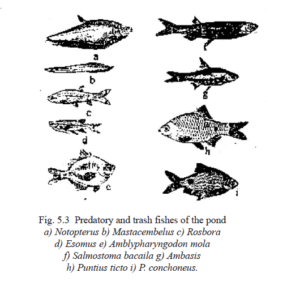
Di kolam manapun, semua ikan rucah dan predator harus disingkirkan sebelum ditebar di kolam. Metode pengeringan dan pengeringan kolam yang sederhana dan kemudian membajaknya paling efektif dalam mengendalikannya. Jika pengurasan tidak memungkinkan, kolam selengkap mungkin, ikan yang tidak diinginkan harus dikeluarkan dari kolam dengan jaring tarik berulang. Namun, banyak ikan yang lolos dari jaring dengan tetap berada di tepi kolam. Penghuni bawah seperti murrel, memanjat bertengger, magur, singhi, dll., yang menggali sendiri di lumpur sulit ditangkap dengan jaring. Dewatering adalah metode terbaik, dimana air harus dihilangkan dengan pemompaan, meskipun ini adalah metode yang tidak ekonomis. Pada kasus ini, cara terbaik untuk menyingkirkan ikan yang tidak diinginkan adalah dengan meracuni air di kolam yang tidak dapat dikeringkan.
Berbagai jenis racun ikan tersedia di pasaran. Ini diklasifikasikan menjadi 3 kelompok - hidrokarbon terklorinasi, organofosfat dan turunan tanaman. Hidrokarbon terklorinasi paling beracun bagi ikan. Ini terakumulasi dalam jaringan ikan dan merupakan senyawa stabil, yang tidak dimetabolisme. Organofosfat kurang beracun bagi ikan, tetapi mereka memiliki efek buruk pada flora dan fauna air. Akumulasinya lebih sedikit di jaringan ikan dan relatif kurang persisten di air. Karenanya, turunan tanaman adalah racun ikan yang baik.
Racun alami terbaik adalah kue minyak mahua, rotenone dari akar derris, kapur cepat (160 kg/ha), kue biji teh (150 kg/ha), kue biji camellia (50 hingga 200 kg/ha tergantung pada kedalaman air), limbah tembakau (150-200 kg/ha) dan bubuk biji kapas (Tabel 6.1). Bahan kimia lain yang aman adalah saponin, yang merupakan senyawa bungkil biji teh dan dioleskan dengan dosis 0,5 ppm di kolam. Sebagian besar racun alami akan terdegradasi dan hilang dari air dalam 7-12 hari. Mahua (Mahuca latifolia) kue minyak adalah racun yang sangat baik, yang terurai setelah 10 hari dan berguna sebagai pupuk. Bahan kimia seperti endrin, dialdrin dan DDT harus dihindari di kolam, karena mereka dapat bertahan di tanah selama bertahun-tahun dan kemudian membunuh semua ikan kolam.
Pemberantasan serangga air (Gbr. 5.4) dibahas dalam pengelolaan kolam pembibitan.
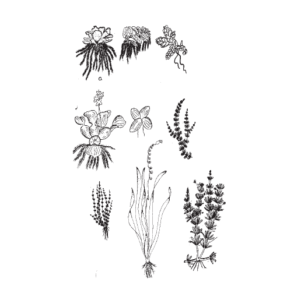
Ara. 5.4 akuatik serangga
- A ) E R e T e S B ) P e S C Ha T Saya kamu S C ) D Saya n e kamu T e S D ) La C C Hai P H Saya aku kamu S e ) S T e M Hai aku Hai P H kamu S F ) R H A n T pada Saya C kamu S G) Limnometra H) Anisops Saya) Diplonychus J) Regimbartia k) Notonekta l) hipoporus M) Laccotrephes n) Sibister Hai) Lithocerus P) hidrofil Q) Ranatra R) Hydaticus S) Sandracott
Pengapuran :
Kapur sering diterapkan dalam praktik budidaya untuk meningkatkan kualitas air. Setelah kolam dibajak, dibersihkan dan dihaluskan, itu harus dikondisikan dengan kapur. Pengapuran meningkatkan produktivitas kolam dan meningkatkan sanitasi. Ini adalah profilaksis dan terapi. Kegunaan utama jeruk nipis adalah;

Ara. 5.5 akuatik rumput liar
- A) Pistia B) C) Azola D) Eichhornia e) Lemna F) Ceratophyllum G) chara
a) Menaturalisasi keasaman tanah dan air.
b) Meningkatkan kandungan karbonat dan bikarbonat dalam air.
c) Menangkal efek racun dari kelebihan Mg, ion K dan Na.
d) Membunuh bakteri, parasit ikan dan tahap perkembangannya.
e) Membangun cadangan basa dan secara efektif menghentikan fluktuasi pH dengan tindakan bufferingnya.
f) Menetralkan senyawa Fe, yang tidak diinginkan untuk biota tambak.
g) Meningkatkan kualitas tanah tambak dengan mempromosikan mineralisasi.
h) Mengendapkan kelebihan bahan organik terlarut dan ini mengurangi kemungkinan penipisan oksigen.
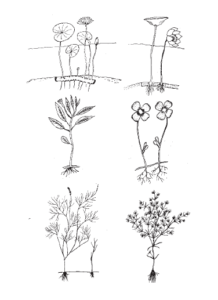
Ara. 5.6 akuatik rumput liar
A) Nymphaea B) Nelumba C) Jussiaea D) Marsilia e) Potamogeton F) Najas
i) Bertindak sebagai disinfektan kolam umum untuk pemeliharaan kebersihan kolam.
j) Kehadiran Ca dalam kapur mempercepat komposisi bahan organik dan melepaskan CO2 dari sedimen dasar.
k) Jeruk nipis membuat tidak tersedianya K bagi alga.
Kolam baru bisa diberi kapur sebelum diisi air. Batu kapur harus tersebar merata di dasar kolam yang kering. Di kolam dengan air, lebih baik untuk menyebar secara merata di permukaan air. Apakah kolam itu baru atau lama, lapisan kapur harus ditempatkan di dasar kolam. Kapur harus ditambahkan ke kolam dua minggu sebelum air dipompa ke kolam. Waktu terbaik untuk aplikasi kapur adalah selama periode ketika pemupukan telah dihentikan. Kapur tidak boleh diterapkan saat kolam sedang dibuahi.
Tanah yang sangat masam (pH 4-4,5) membutuhkan dosis kapur 1000 kg/ha, sedangkan tanah agak masam (pH 5,5-6,5) membutuhkan sekitar 500 kg/ha kapur. Tanah yang hampir netral (pH 6,5 hingga 7,5) hanya membutuhkan kapur 200-250 kg/ha. PH tanah tambak harus dibawa ke hampir netral untuk manfaat maksimal.
W pada eri n G :
Setelah kapur dioleskan ke dasar tambak setidaknya selama dua minggu, air harus dibiarkan perlahan-lahan. Air harus jatuh dari saluran masuk air ke kolam, sehingga air bercampur dengan oksigen dari udara saat jatuh ke kolam. Air tidak boleh masuk ke kolam terlalu cepat. Jika air masuk terlalu cepat, dasar kolam akan teraduk dan dengan demikian membuat air menjadi keruh. Layar harus digunakan di saluran masuk, sehingga ikan dan organisme lain yang tidak diinginkan tidak akan masuk ke dalam kolam. Kolam harus dibiarkan bebas selama beberapa hari setelah diisi. Kualitas air di kolam harus diperiksa sebelum ikan dilepaskan ke dalamnya.
ibu n kamu Saya ng :
Ikan membutuhkan unsur-unsur tertentu untuk tumbuh dan berkembang biak. Unsur-unsur tersebut adalah C, H2, O2, N2, K, P, S, Ca dan Mg. Beberapa elemen lain, disebut elemen jejak seperti Cu, Zn, M N, bu, B, dll., dibutuhkan hanya dalam jumlah kecil. Jika unsur-unsur ini hilang atau ada dalam jumlah yang sangat rendah, ikan tidak akan tumbuh dengan baik. Ikan mendapatkan unsur-unsur ini dari tanah tambak, air kolam dan makanan yang mereka makan. Beberapa kolam ikan kekurangan elemen yang diperlukan untuk pertumbuhan dan produktivitas ikan. Dalam kasus-kasus ini, perlu menambahkan pupuk ke dalam air. Pupuk adalah bahan sederhana yang mengandung unsur-unsur yang hilang. Unsur yang paling sering hilang atau kekurangan pasokan di kolam ikan adalah N2, P dan K. Pupuk yang mengandung unsur-unsur yang hilang ini ditambahkan ke kolam ikan untuk membantu pertumbuhan ikan dan plankton, yang digunakan ikan sebagai makanan.
Kolam yang kaya fitoplankton biasanya berwarna hijau cerah. Warnanya menunjukkan mekarnya alga. Dalam mekar normal, cakram secchi menghilang pada kedalaman sekitar 30 cm; ketika piringan secchi menghilang pada kedalaman 20-40 cm, tambaknya sangat produktif dan subur. Tidak ada pupuk yang dibutuhkan di kolam dalam kondisi ini.
Terkadang kolam bisa menjadi terlalu subur. Jika cakram secchi menghilang hanya pada jarak 15 cm, bunganya terlalu tebal. Lapisan hijau yang tebal menghalangi sinar matahari di kolam dan tidak ada oksigen yang bisa dilepaskan oleh fitoplankton. Pada kasus ini, ada terlalu banyak pupuk di kolam, dan karenanya beberapa lapisan tebal alga yang terbentuk di permukaan air harus dihilangkan. Kolam ini tidak membutuhkan pupuk apapun.
Jika piringan secchi masih terlihat pada kedalaman 43 cm, plankton di kolam tidak mencukupi. Dia, karena itu, perlu menambahkan pupuk ke air kolam untuk mempersiapkan kolam yang subur. Faktor lain yang menentukan kebutuhan pupuk adalah kualitas tanah. Jika tanah sangat produktif, kebutuhan pupuk lebih sedikit; jika tanah tidak begitu produktif, kebutuhan pupuk lebih besar.
Pemilihan pupuk dapat ditentukan berdasarkan komposisi fisik tanah. Pada tanah berpasir atau lempung berpasir dengan bahan organik rendah, pemupukan dilakukan dengan pupuk organik. Pada tanah lempung dengan bahan organik sedang, kombinasi pupuk organik dan anorganik harus diterapkan. In highly clay soil with rich organic matter, fertilization is carried out with only inorganic fertilizers. Amount of fertilizers to be applied to ponds may be worked out on the basis of the productive potentiality of the pond. The ponds can be categorised on the basis of N, P, organic carbon and alkalinity (Table 5.1).
In case of deficiency of potash, it can be included at the rate of 25-50 kg/ha/yr. The NP ratio should be 2:1. Tambahan, cow dung may be applied at a rate of 10, 000-15, 000 kg/ha/yr. The best way to use this
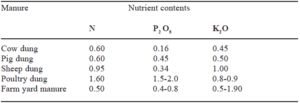
animal manure is to make a soup of it in a tank by mixing it with water. This soup should be spread in the pond. Fertilizer should be applied at a rate determined by the area of pond. Area is the length of the pond, multiplied by the width. Sebagai contoh, if a pond measures 20 m in length and 10 m in width, it has an area of 200 square metres (m2). This is equivalent to 2/100 of a hectare. To fertilize a 200 m2 fish pond with cow dung, at the rate of 1000 kg/ha, you must use only 20 kg.
Fertilization should be done 2 weeks prior to stocking the fish, yang seperti itu, sufficient natural food is available in the pond. 1/5 of the total quantity of organic manure is required as an initial dose, and the rest is applied in 10 equal instalments. Organic and inorganic fertilizers may preferably be applied alternating with each other in fortnightly instalments. The amount of fertilizers required in general for fish ponds is 10, 000 kg/ha/yr of cow dung, 250 kg/ha/yr of urea, 150 kg/ha/yr of single superphosphate and 40 kg/ha/yr of murate potash. In large ponds, fertilizers may be applied by using boats.
NS Hai kin G
Stocking is used to describe the act of placing the fish into the pond. The stocking density is used to describe the total number of fishes, which can be stocked in a pond. The stocking ponds are generally stocked with fingerlings which are about 75-100 mm in size. For increasing fish production, the selection of fish with desirable qualities is the most important biological factor. Since fish with the shortest food chain give the highest production, phytophagous, herbivores, omnivores and detritus feeders are preferred for culture in stocking ponds. For rearing of fish, either monoculture or polyculture in any species, combination may be carried out, most preferably the polyculture. The desirable stocking rate is 5, 000 fishes per hectare. In a monoculture pond, the stocking rate is the same as the stocking density because there is only one kind of fish. There is enough food and room in a pond for a particular number of fish. Good growth of fish depends upon the right number of fish cultured in the pond.
The stocking rate depends on the volume of the water and on the oxygen balance of the pond rather than the size of the pond. The ratio of fish to the volume of water should not be less than 1 fish to 2 m3 of water where there is no forced aeration.
As far as possible each pond should be stocked with silver carp and catla, the surface feeders. This should not be more than 30 to 35%, otherwise it would affect their growth adversely. Rohu is a column feeder and it should not be stocked more than 15-20%. Bottom feeders such as mrigal and common carp together can be stocked to the extent of 45%. Availability of aquatic weeds in the pond decides the stocking density of grass carp. It should preferably be about 5-10%.
Rearing of fingerlings to table-size fish may continue for one year or only 6 months. In the latter case, the stocking density may be reduced. Dalam sistem ini, harvesting is done monthly and the number and species of harvested fish are replenished with a new stock of fingerlings. This is possible only where the supply of fingerlings is available throughout the year. Under these conditions the production is much higher than with the annual or 6 monthly stocking and harvesting.
In a polyculture of Chinese carp, the stocking density is about 20, 000 fingerlings per hectare. The stocking rates are 5, 000 grass carp, 5, 000 bighead carp and 10, 000 silver carp. If common carp is also included, then in a stocking density of 7 Chinese carps, 2 fish would be grass carp, 3 would be common carp, and there would be only one each of bighead and silver carp. Di Malaysia, the ratio of carp stocking has been suggested at 2:1:1:3 for grass carp, bighead, silver carp and common carp.
If fishes are stocked in a pond, there should be enough oxygen, no temperature difference between the stocking water and the pond water. When the fingerlings are transported from a far away place, in order not to stress the fish, the bags with fingerlings are placed in the pond unopened until the water temperature inside the bags is about the same as the temperature in the pond. When it is same, the fingerlings are allowed to swim out of the container into the pond water by themselves. The fingerlings should not be poured into the pond water, as they die because of the shock of hitting the water.
Pos T -stock Saya n G mengelola M en T
W A te R sebagai aku dia kamu Pria A permata e n T
Water quality managment is discussed in detailed
F e e D Mana G em n T
The feed management is discussed in detailed in chapter 6.
Sembuh T H manajemen T
The health managment is discussed in detailed in chapter 7
Harv e stin G
The fishes are harvested after a one year with the help of gill nets. Five to Six fisherman depending up on the size of the pond enter into the pond from one side, move to wards the other end with gill net and catch the fishes.
akuatik rumput liar dan milik mereka controle
Aquatic vegetation is described as aquatic weeds. Any undesirable vegetation which causes direct or indirect damage to the fishes or hamper the fishery operations may be described as weeds. In the tropical regions of the world, aquatic weeds grow luxuriantly causing nuisence to fisheries, water transportation and water supply systems, and provide conducive habitat for factors of several diseases. Di India, ponds and tanks usually have fertile soil and water and so they invariably overgrow with all types of aquatic vegetation. For successful farm management, a strict watch on the growth of unwanted vegetation is necessary. With the presence of excess vegetation it becomes very difficult to net fishes in weed infested ponds.
rea S pada S FO R C ont peran Hai F gulma S
Uncontrolled vegetation growing excessively hinder fisheries interest in many ways. The weeds in the water reduce the yield of fish just as the weeds in the field reduce the yield of cultivated crop. It is necessary to control the weeds in fish ponds. Some of the reasons for this are quite obvious.
1. Due to the presence of aquatic weeds in the pond, the fishes cannot swim properly, thus restricting their ability to browse and hunt for food.
2. Weeds absorb nutrients for their growth and multiplication, thus absorbing nutrients essential for planktonic food of fishes which causes depletion offish food. Due to their presence, water loses its fertility to sustain fish stock.
3. Weeds offer shelter to unwanted predatory and weed fish, which hunt upon or compete with the cultivated varieties.
4. By profuse growth, weeds choke the entire water column, restrict netting and make navigation impossible.
5. The presence of weeds in water reduces the water holding capacity of the area and water loss due to evaporation through leaves occurs. In case of few weeds, the evaporation is much more than that from the open surface.
6. Weeds cause wide dirunal fluctuation in dissolved oxygen, temperature and other physico-chemical parameters to make the water inhospitable for fishes.
7. The weeds accelerate the process of siltation of the water area, ultimately turning it into a swamp.
8. Weeds harbour harmful insects, frogs, snakes and other predators enabling them to breed and multiply.
9. Weeds choke the gills of the tender young fishes.
10. The weeds interfere with the circulation and aeration of water, restrict the diffusion of sunlight and upset the normal chemical balance of the system.
11. The toxic gases in the pond bottom ooze produced by rotting organic matter cannot be easily eliminated into the atmosphere if the water surface is choked with weeds. In these conditions very few fish could survive in the water.
1 2 . Aquatic weeds are responsible for minimising water depth and ultimately cutting down the soil-water interaction which is so essential for recycling of nutrients for the fishes.
13. Thick algal blooms deplete the oxygen in the water during dark hours or when they die or rot and cause sudden mortality of the fish stock.
14. Some kinds of algae cause allergic irritations on human skin and make it difficult for people to get into the pond.
15. The fish yield is reduced in weedy infested water bodies. 16. Weeds affect water irrigational potential.
A dva n tanda S Hai F w e ed S
Weeds do not always have harmful effects. The weed mass can be turned to some productive use which will recoup some of the losses involved in controlling them. The extra advantage of the utilization method lies in producing valuable end products. Different methods of control and utilization of weeds should be seen as useful tools in an integrated system of aquatic weed management. The aquatic weed are advantageous and help in the development and maintenance of a balanced aquatic community. The advantages are:
1. Aquatic weeds produce oxygen during photosynthesis and this oxygen is utilized by the fishes.
2. Weeds provide shelters for small fishes.
3. Weeds provide shade for fishes.
4. Weeds provide additional space for attachment as well as food for aquatic invertebrates which in turn serve as food for fishes.
5. Weeds help in the precipitation of colloidal clays and other suspended matters.
6. Weeds, after removal, can be used as bio-fertilizers and even used in fish farms.
7. Aquatic weeds are used as food for fishes like grass carp.
8. Weeds are also used for pollution abatement.
9. Weeds are used as a source of energy production.
W e e D S A S FO Hai D FO R F adalah H
There are a number of herbivorous fishes which directly consume aquatic weeds. The grass carp is a fast growing fish that feeds on aquatic weeds. The fish utilize submerged weeds like Hydrilla, Najas, Ceratophyllum, Ottelia, Nechamandra dan Vallisnaria in that order of preference. The young fish prefer smaller floating plants like Wolffia. Lemna, Azolla dan Spirodela. In composite fish culture the production is greatly enhanced by inclusion of grass carp because of its fast growth. It also occupies an ecological niche, which otherwise remains unfilled with the fear that the grass carp may breed and compete with the native fish population in natural waters, only the triploid grass carp which is supported to sterile is being allowed to be introduced.
The other herbivorous fish which utilize aquatic weeds are Pulchelluspulchellus, Oreochromis dan Etroplus. Though an omnivore, Cyprinus ikan mas feeds well on filamentous algae like Pithophora dan Cladophora. The manatee, Trichechus sp., a large air-breathing herbivore, is being utilized for the clearance of aquatic weeds in the canals of Guyana.
These advantages of water plants become negligible when they are present in excess and their control then, sangat penting. The methods to be adopted to control the aquatic vegetation can be formulated only after the plants are identified.
F A ct Hai R S C Hai ntr Saya bu T di dalam G T Hai P rofuse G baris
A number of factors either individually or jointly influence favourable growth of weeds in cultivable waters. These are :
1. Climatic condition and geographical situation of the area.
2. Water depth – lesser the depth, more is the growth of vegetation especially the submerged rooted or emergent vegetation.
3. Clarity of water or turbidity – more suspended material adds more turbidity thus retarding penetration of light in the pond which has an effect on the growth of vegetation.
4. Silt deposition at the bottom, promotes excessive growth of aquatic weeds.
5. Quality of water – fertile condition of water has its impact on the propagation of vegetation.
6. Infestation from other sources – the minute generative vegetative components like spores and cysts may be carried through the water supply, angin, flood, birds, ternak, dll.
T kamu pe S Hai F aq kamu pada Saya C wee D S
The aquatic weeds (Fig. 5.5 and 5.6) are classified on the basis of habitat of plants – rooted weeds and floating weeds.
R Hai atau e D w ee D S
1. Bottom rooted weeds :Plants are rooted at the bottom of the water body and spread within the bottom layers of water. Vallisneria, Ottelia
2. Submerged rooted weeds :The plants are rooted in the bottom soil on the deeper margins of the pond and ramifying in the volume of water. misalnya Hydrilla, Chara, Potamogeton
3. Marginal rooted weeds :Plants are rooted on the marginal region of the surface layer of water and ramify on the surface of water and also on the adjoining land. misalnya Marsilia, Ipomoea, Jussiaea
4. Plants are marginally rooted and ramifying within the marginal region of the water volume. Misalnya. Typha, Scirpus, Cyperus, Panium
5. Emergent rooted weeds :Surface plants which are rooted in the bottom of the pond but their leaves float on the water surface or rise above the water level. They prefer shallow parts and shores of the pond. G. Nymphea (Lotus), Nymphoides, Nelumbium .
Flo A timah G gulma S
1. Surface floating weeds :The plants are floating on the surface of water and with roots in the water. misalnya Eichhornia (water hyacinth), Pistia, Lemma, Azolla, Spirodele . Few surface plants, are floating on water but without roots g. Wolffia .
2. Submerged floating weeds :The plants are floating but submerged in the water e.g. Ceratophyllum, Utricularia .
3. We can also divide the aquatic weeds broadly as floating, emergent, submerged, marginal weeds and algal blooms and filamentous algae.
sabu Hai D S Hai F wee D bersama n T peran
Based on the intensity of infestation and type of weeds, the aquatic weeds can be controlled by means of manual, metode kimia dan biologi.
A . M NS kamu A aku A n D Aku C han Saya ca aku Aku T ho D
When infestation is scanty and scattered, the weeds can be controlled manually only in small water bodies. This is an ancient method and is still practiced in most of the places. The pre-monsoon period (April-May) is more suitable for manual removal. In many parts of the country, advantage is taken of the drought to control the weeds as ponds and other water bodies dry up or register a sharp fall in the water area, and the plants can thus be removed. Where labour is cheap, manual labour is often employed to remove aquatic weeds. The weeds are controlled manually by hand picking, uprooting the emergent and marginal weeds and cutting the others with scythes.
Most of the floating plants like Pistia, Lemna, Azolla, Wolfia dan Eichhornia can be effectively controlled by clearing manually with nets, sedangkan, the marginal weeds like grass, sedges, rushes, Typha , etc. may be controlled by repeated cutting. This method does not inflict any pollution and there remains no residual toxic effect as in the case of chemical treatment or shading. The weeds thus collected should be dumped far away, be converted into compost manure or burnt so as to have no chance of reinfestation.
Manual weed control is very expensive, time consuming and unsatisfactory. Karena itu, mechanical devices have been developed. Cleaning of a weed infested water sheet through the mechanical method, becomes necessary where the water area is not shallow enough to walk through or small enough to uproot the weeds manually or cut them effectively with simple hand implements. Labour problem and an urgency of the work to eradicate the whole area of weeds within a stipulated time period before water level is raised, are the other factors which make it necessary to resort to mechanical methods for eradication of weeds.
A number of devices ranging from very simple barbed wire bottom rakers to sophisticated mechanical equipments like power winches with steel wire, under-water cutter, dredgers, mechanised removers, etc. are in vogue to use for the purpose. Broomfork, long fork, sickels or scythes, long knives, barbed wire netting, chaining and motor powered weed cutters are some of the specialised equipment used for this purpose.
Crusher boats are used to clear water bodies infested with water hyacinth. The rooted submerged weeds are dislodged mechanically by dragging with log weeders fitted with spikes and barbed wires. Mechanical winches are used for cutting and dragging of submerged weeds.
Another simple method of control of water hyacinth is to construct floating barriers which prevent water hyacinth from reaching other water bodies. The floating barriers reduce time, labour and cost as the accumulated weed is removed by draglines.
Laser rays are also used to control water hyacinth, usually of 10.6 nm wavelength. The irradiated plants are plasmolysed immediately.
Burning follows in proportion with the amount of laser energy applied. Many of the plants die within ten weeks. Daughter plants are stunted and turned pale due to destruction of chlorophyll.
C hemic A aku C Hai kendali :
A large number of chemical weedicides are used for control of aquatic weeds. It is a very effective and cheap method. The weedicide is to be selected in such a way that it should be cheap and easily available, non-toxic to fish and man, should not pollute the water and should not involve the use of special and costly equipment. The lethal action of the weedicide is either by direct contact or by translocation of chemicals from the treated part of the plant to the other areas of its system resulting in both cases in the death of the plant.
Different type of chemicals are in use for eradication of weeds. Many of these are poisonous, toxic or harmful for human and other animals. Their mode of action on the weeds are also different. The same chemicals may not be useful for the eradication of different types of weeds.
Chemicals used for eradication of weeds are broadly classified under three categories.
1. Compounds of heavy metals. misalnya Copper sulphate, Sodium arsenate, dll.
2. Hormone weedicides g.2, 4-D, 2, 4, 5-T, dll.
3. Fertilizers. G. Superphosphate, Urea, Ammonia, dll.
According to the mode of action, a weed killer chemical can also be grouped into two categories.
1. Contact weedicides – which kill plants on contact.
2. Translocated weedicides – which are absorbed by plants and are killed.
The contact weedicides may be selective or non-selective killer types. The selective killer type of chemicals are effective only on some specific weeds whereas the non-selective type chemicals kill all types of weeds. Besides weedicides, some chemicals are used as soil sterilants. It shows that all chemicals are not suitable for killing all types of weeds and all the chemicals may not have all the qualities required for commercial use. Some chemicals are extremely poisonous for animals and human beings. Some chemicals like fertilizers are required to be applied at a very high dose which is neither economical not easy to apply. Endothal, Endothal amine salt, 2, 4-D are toxic to fish. Diquot is toxic to fish and not advocated to apply in muddy water.
Biolo G ica aku menipu T peran :
Of all the weed controlling measures, biological control of weeds through stocking the water with weed-eating fish, such as grass carp, Ctenopharyngodon idella, is found to be an effective and satisfactory method. Grass carp is a voracious weed eater and possesses strong pharyngeal teeth, which enables it to grasp and nibble at soft weeds like Hydrilla. The nature of its gill rakers helps it to sieve large quantity of microvegetation from the water body. Because of its efficiency for weed consumption and convertibility into flesh it is preferred for stocking in weed infested waters.
Grass carp usually eat the soft parts of the aquatic plants leaving behind the harder parts like stem. It shows a certain preference for soft submerged weeds like hidril , Ceratophyllum , Najas , Vallisneria . Its lower preference towards Ipomea is due to the hard nature of the weed. hidril verticellata is the most preferred as it has soft leaves which could be easily nibbled and are easily digested.
Control of weeds, especially the soft submerged type of weeds, through biological control by stocking the water with grass carp has certain advantages. It is not only the most economical due to its low cost of operation and easy application but also does not contaminate the water with toxic substances unlike chemicals used for control. Lebih-lebih lagi, it gives economical returns by increased fish production.
Common carp, Cyprinus ikan mas and Katti, Acrossocheilus hexagonalepsis and ducks are also used for biological control of aquatic weeds. Beatles and stemborers are also recommended for the purpose.
Biological control of weeds may be done by shading. Increasing turbidity, covering the surface by controllable floating weeds, shading the water area by canvas or coloured polythene sheets to cut down sunlight in order to check excessive growth and vegetation are some of the methods also in use.
Whichever method is used for the control of aquatic weeds, employment of manual labour is necessary. In the mechanical method labour is necessary for the clearance of the remains of the vegetative parts of the weeds. Even if the chemical method is resorted to, the dead weeds which sink to the bottom have to be removed. A rational utilization of all methods suitable according to the local condition and also economical is to be resorted to for eradication of weeds. Namun, checking of excessive weed growth at the proper time is also one of the effective and important factors to keep the weed under control. Control measures should be adopted before the flowering season of the weeds. The time for control of weeds given below has been found to be appropriate under Indian conditions.
January-February March-May
June-July July-August
August-September October-November
- Eichhornia, lotus – Duck weeds
- Utricularia, Ottelia - Jussiacea, Trap,
n ymphoides , P istia , Nechamendra
- Najas, Myriophyllum - Scrispus, Nymphaea
W A te R kualitas T kamu M anageme n T
Successful pond culture operations mainly depend on maintenance of a healthy aquatic environment and production of sufficient fish food organisms in ponds. Water is the primary requisite to support aquatic life. Physical, chemical and biological factors play an important role in governing the production of fish food organisms and fish production in the pond. Water not only plays an important role in the fish production, but also it helps in the survival and growth of the fish. Karenanya, fish farmers should take a lot of care to maintain hygienic conditions in the pond, so that they get more profits. If the water quality is maintained with utmost care, the farmers need not spend much money for curing the diseases. If the water quality is maintained, the fishes also have a good taste. Water quality is influenced by physical, chemical and biological factors.
Fisika A aku faktor S
The physical condition of water is greatly influenced with depth, suhu, turbidity, light and water colour.
W A T e R dept H
Pond depth has a vital bearing on the water quality. Depth determines the temperature, the circulation pattern of water and the extent of photosynthetic activity. In shallow ponds, sunlight penetration upto the pond bottom and facilitates an increase in the productivity. A depth of 1-2 metres is considered optimal for biological productivity of a pond. If the depth is very less, water gets overheated and thus has an adverse effect on the survival of the fish.
W A te R suhu e ratur e
Temperature affects fish migration, reproduction and distribution. It depends on climate, sunlight and depth of the pond. Temperature varies vertically in the water body and also shows diurnal fluctuations. Fish posses well defined limits of temperature tolerance with the optimal being 20-32°C. Indian major carps can thrive well in the temperature range of 18-38°C. Wide fluctuations of water temperatures affect the survival of fish. In very low or very high temperatures, the fishes are strained, spend more energy and growth of the fish is affected. These temperatures also affect the chromatophores of prawns, and the prawns develop a red colour. If the temperature is maintained optimally, the red colour disappears. At low temperatures the food consumption offish and prawns decreases and gasses are produced at high temperatures. Karenanya, water temperature maintenance is very essential to obtain high yields. Fish and prawns or their seed have to be acclimatized whenever they are transferred from one pond to the other.
T kamu rbi D dia kamu
Water turbidity is mainly due to suspended inorganic substances like clay, lanau, phyto – and zooplankton and sand grains. Ponds with a clay bottom are likely to have high turbidity. Turbidity reduces sunlight penetration and photosynthesis and hence acts as a limiting factor. If the turbidity is due to more suspended particles, they absorb nutrients in their ionic form, making them unavailable for plankton production. High turbidity also reduces the dissolved oxygen in the pond water. Turbidity is measured with the secchi disc. If the secchi disc disappears at 30-50 cm. the water is productive in nature. If it is not visible at a depth less than 25 cm, a dissolved oxygen problem could anse during the night. If it is more than 50 cm, the plankton produced is less in the pond water. In less turbid waters, the aquatic weeds growth is more. In highly turbid waters, the sand grains accumulate in the gills of the fish and prawns, causing suffocation and excessive secretion of mucous. High turbidity can be reduced by adding lime and alum. If the water is more turbid, it should be stored in sedimentation tanks and then used for fish culture. If the turbidity is more due to phytoplankton, water m the pond should be changed. Fertilizers have no effect in high turbid waters, hence fertilization of the pond should be stopped.
L Saya gh T
Availability of light energy to a fish pond greatly influences its productivity and photosynthesis. In shallow ponds, light penetrates to the bottom and is responsible for luxuriant growth of aquatic weeds. In high turbid waters, the light will not penetrate to the bottom. Due to this, the vegetation at the bottom will decay and produce harmful gasses, which affect the fish and prawn life.
W pada e R C Hai lou R
Water gets its colour due to phytoplankton, zooplankton, sand particles, organic particles and metallic ions. Water used for fish or prawn culture should be clear, either colourless or light green or blue in colour. Water colour is golden or yellow brown if diatoms are more. This type of water is best for prawn culture. Brownish green, yellowish green and light green coloured waters are also good for prawn culture. Water becomes greenish in colour when phytoplankton is more, develops a brown colour due to zooplankton and mud colour due to more sand grains. Water with black, blackish green, dark brown, merah, yellow colours are not good for culture. These colours are due to the presence of more phytoplankton, bad pond bottom and acids in the water. The red colour of water is due to the presence of high levels of iron and death of phytoplankton (phytoerythrin released).
kimia aku wajah T atau S
The chemical factors like pH, oksigen terlarut, alkalinity, hardness, phosphates and nitrates influence the productivity of the pond.
P H
pH is the hydrogen ion concentration, which ranges from 0-14. Water is slightly alkaline in condition, with the optimal range of 6.5-8. Less than 5 and more than 10 pH is lethal to fish and prawns. The pH of pond water undergoes a diurnal change, it is alkaline during the day time and slightly acidic just before day break. The fluctuations of pH are similar to dissolved oxygen. pH fluctuations are more in phytoplankton and weed infested waters and water with less hardness. No sudden pH fluctuations in brackish water and sea water occurs due to their buffering capacity.The difference in pH from morning to evening should not be more than 0.5. When pH increases, ammonia and nitrites become toxic, when it is reverse H, S becomes more toxic. pH below 6.5 and above 8.5 is responsible for reduction of growth and resistance of parasitic infection increases in acidic waters. Whenever pH falls, lime should be added to the pond water. When pH is high, lime should not be used. Urea should not be used to reduce pH. This is because NH3 becomes toxic at high pH. It is always better to add new water to maintain an optimal pH. Alum or aluminum sulphate can be used to reduce the pH and turbidity. Alum removes phenolphthalin alkalinity. 1 ppm alum reduces 1 ppm phenolphtahlin alkalinity. Ikan, prawns and their seed should be acclimatized to new water whenever they are transferred from one pond to another.
Di S menyelesaikan D oksigen n
Dissolved oxygen is one of the most important chemical parameters, which has a great influence on the survival and growth of fishes and prawns. The pond water gets oxygen mainly through interaction of atmospheric air on the surface water of the pond and by photosynthesis. It is produced only during daytime, reaches a maximum at 3 PM, then gradually decreases upto early morning. During the night it decreases and it reaches a minimum during the early hours. It is due to nil production of dissolved oxygen at night and instead, consumption of oxygen by plankton, weeds, fishes and prawns. During overcast days, the production of dissolved oxygen during the day is less and during the subsequent nights it decreases drastically. Ketika suhu air naik, oxygen is released into atmosphere. When salinity increases it is dissolved in water. The optimum dissolved oxygen is 5-8 ppm. If less than 5 ppm the growth rate decreases the fish and prawns are prone to get diseases and less than Ippm of dissolved oxygen results in death. More than 15 ppm results in gas bubble disease in fishes and prawns. Whenever the animals are under stress due to less dissolved oxygen the food consumption temporarily decreases. When oxygen decreases, prawns accumulate on the water surface and near the pond shores and are found stationary at one place or show weak movements. Fishes come to the surface and engulf the air. Prawns get milky white spots when dissolved oxygen is continuously less. It decreases gradually from the surface to the pond bottom and CO, , NH3 and other gases increases, hence prawns are under more stress. Farmers should take precautionary measures at nights, especially during the early hours to increase oxygen levels. If it is very less, the water surface should be disturbed by beating water with bamboo poles or by rumming boats or by using aerators.
Alkalinit kamu
Alkalinity is caused by carbonates and bicarbonates or hydroxides of Ca, Mg, Tidak, K, NH4 and Fe. Alkalinity is less in acidic soils and in ponds with more organic load. Alkalinity is more in clay soil ponds and is increased if water is pot exchanged. The optimal level of total alkalinity is 40-150 ppm. Alkalinity has direct effect on the production of plankton. '
H ar D tidak S S
Hardness is caused by Ca and Mg. Water with less than 40 ppm is soft and more than 40 ppm is hard water/ The pond water with a hardness of 15 ppm or more is satisfactory for growth of fishes and prawns and do not require additional lime. If water has less than 11 ppm hardness it requires liming for higher production. If it is less than 5 ppm, the growth rate is affected and causes eventual death of the fish.
S alin Saya T kamu
Tidak, C12, Ca, Mg, K, bicarbonates and sulphates are responsible for salinity of the water. Salinity is an important parameter for survival, growth and high production in brackishwater culture systems. Salinity ranges between 0-40 ppt in brackishxvater and 35 ppt in sea water. The optimal salinity for prawn culture is 15-20 ppt. The prawns can survive at 2 ppt and 40 ppt. but their growth rate decreases. If the salinity is high, the water should be exchanged. Due to heavy rains more freshwater enters into the ponds and sudden decrease is found in salinity levels which affect the life in the pond. To avoid this, two outlets (one at high level and other at low level) should be provided to send out freshwater and sea water separately from the pond. The animals should be acclimatised before introducing them into new water.
Ca R bo n dio x Indo e
BERSAMA, is produced during respiration and consumed during photosynthesis. BERSAMA, is less during daytime and more at nights. The optimal level of CO, is 5 ppm. At high CO, tingkat, pH decreases, BERSAMA, is accumulated in the blood of the animals and water becomes acidic. The animals become sluggish, loss of resistance occurs, they cannot utilize dissolved oxygen and they ultimately die. Whenever CO, increases lime should be added to the pond. 1 ppm of lime reduces 0.9 ppm of CO, .
Di S sendirian v e D amm Hai ni A NS D Saya T S C Hai mpo kamu dan S
NH3 is found in excreta and is also released due to decomposition of organic matter. It is an important compound influencing the growth of phytoplankton in the aquatic ecosystem. The optimal limit of NH3 is 0.3-1.3 ppm and less than 0.1 ppm is unproductive. Whenever NH3 increases pH also increases, but dissolved oxygen decreases. CO2 reduces the toxic effect of NH3. NH3 also increases with feed due to high protein levels and death of phytoplankton. When NH3 is more in water, animals may not get excreta with NH3. NH, accumulates in the blood and oxygen transport in the blood reduces. – Gills become black, biochemical tissue is damaged and gasous exchange is affected. NH3 levels can be reduced with good management like no excess feed, optimal stocking and water exchange. Lime should not be added when NH, tinggi. Optimal level of nitrites is 3.5 ppm.
hidro Hai ge n sulp H Indo e
H2S is produced in anaerobic conditions by the action of-micro-organisms on sulphur compounds. H, S is toxic to fish and prawn. It should be less than 0.05 ppm in pond water. H2S is responsible for respiratory problems. When H, S increases, lime should be added.
B Saya ologi C A aku fakta Hai R S
The biological factors like plankton, weeds and disease causing agents also play a role in water quality maintenance.
Rencana k ton - air R qu A menyala kamu
Plankton are free living smaller plants and animals, which move along with the waves. Plankton are natural fish food organisms, which consists of 60% easily digestible proteins. Phytoplankton produce food and O, by photosynthesis. Plankton density variations depend upon the fertilizers used and fish species cultured. Carbon, oksigen, H, , P, N, , S, Fe, K, Tidak, M N, bu, Zn, B and Cl, are essential for plankton production. Out of these, N, P, K, are most important elements for plankton production.
To increase plankton production, organic and inorganic fertilizers should be used. Lime is also essential for plankton production. Fertilizers and lime should be used at regular intervals. This helps in production of plankton in sufficient quantities. Excess production of plankton, especially myxophyceae members settle on the water surface and form algal blooms. This hampers photosynthesis and oxygen depletion is observed, esp£Cially during nights. BERSAMA, levels increase in the pond and affect water quality.
penyakit S e kau S di dalam G A G ent S — air R kualitas kamu
The most important aspect of water quality management in the culture system is to maintain fish without disease causing agents and under hygienic conditions. The diseases in fishes and prawns are caused by bacteria, virus, jamur, protozoa, helminth, and crustacean parasites. These parasites enter into the pond along with water, fish or prawn seed and nets from other infected ponds. Due to the unhygienic conditions these parasites cause diseases in fish and prawns, and the fish and prawns become less resistant to diseases. Due to the parasitic infection the growth rate reduces and finally they die. To avoid these bad effects, use good and healthy material and fish and prawns should be examined once in 15 days. Abnormal behaviour offish and prawns is observed in infected ponds. These should be observed and immediate action should be taken, sebaliknya, whole crop could be wasted / destroyed.
air T Saya C w ed S - w A te R kualitas kamu
Excess growth of aquatic weeds in fish pond is not a good sign in aquaculture systems. Weeds utilize the nutrients and compete with desirable organisms. Weeds also compete for oxygen, especially during nights and space with fishes. They obstruct the netting operations too. Karenanya, the weeds should be removed from ponds by mechanical, chemical or biological methods. Application of lime, fertilizers and feed are some of the important measures to maintain the water quality. These should be applied whenever required. Excess application leads to the poor condition of water quality.
peran e Hai F aer A untuk S Saya n th e w A te R qu A menyala kamu M anag e laki-laki T
Atmospheric oxygen dissolves in the water at water surface. In this layer, dissolved oxygen increases quickly, but not at the pond bottom./To get oxygen even in the bottom layer, the pond water should be disturbed. To gedhis aerators are very essential. Aerators produce the air bubbles, which disturb the water in the pond, so that more oxygen dissolves in the water.Aerators, therefore play a vital role in aquaculture to increase fish and prawn production.
Different types of aerators are in operation to increase aeration in the ponds. Diffused, air lift pumps, U-tube and splashers are some of the common aerators (Fig 5.7) in operation in aquaculture.
In diffused type, the blower or compressor is arranged on the dyke, and this is connected to a porous tube, which is arranged on the pond bottom. Compressor produces air, which comes out of the porous tube in the form of air bubbles and disturbs the water to produce more dissolved oxygen. The capacity of the aerator depends upon the compressor energy and pond depth.
In air lift pump aerator, air is sent into a tube, which opens on surface of the water. Air bubbles travel through the tube and enhances the dissolved oxygen. This aerated water falls on water surface and increases dissolved oxygen water further.
In U-tube aerator, the U-tube has 12-18 metres depth. At one end. air is pumped with the help of blower and the air bubbles travel to the other end i.e., air bubbles have more contact time with water. These aerators are more efficient, but need more expenditure for construction. Splasher type of aerators are also known as surface aerators. Propeller of the aerator is arranged near the water surface and water is sprinkled which helps in enhancing the oxygen in the pond. Paddle wheel surface aerators are also used in fish ponds. Sprinklers are used in fish ponds where porous pipes are arranged on the water surface and pump the air is pumped with engines into the pipes. This gives good aeration in the pond and produces successful results (such as those obtained in Kolleru area).
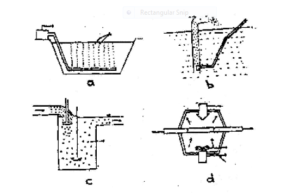
a) Diffused type b) Air lift type c) U-tube type d) Splasher type
peran e Hai F F Saya filter S Saya n th e apa e R sebagai aku dia kamu M A mengomel e laki-laki T
Aquatic culture systems contain living organisms in water.These organisms require inputs, such as food and they excrete other materials. The inputs must be mixed with or dissolved in water to be available to the organisms, whose outputs will also become mixed with or dissolved in water. Excessive output and/or input can become toxic if the concentration is allowed to increase in the culture water. The process of removing excess materials is called filtration. It consists of passing the water through a thick layer of sand and gravel which act as strainers. Suspended and colloidal matter in the water and also a large number of bacteria are caught in the interstices of the sand during its passage. The mechanical, biological and airlift filters are generally adopted in aquaculture practices to manage and control the water quality for intensive rearing and culture.
mekanik Saya ca aku menyaring e R
A mechanical filter (Fig 5.8 a) is an under drained water tight basin in which the filtering materials are placed. The size of a mechanical slow sand filter unit may be about 30 to 60 m x 15 to 30 m or more and about 2.5 m to 3.5 m deep according to desired flow. Water after passing through the filter is collected in an outlet chamber, which is equipped with a flow regulating arrangement. The filtering material about 90 cm to 150 cm of which about 60 cm to 90 cm is fine sand, is laid on top of the under drainage system in five or six layers in progressively smaller sizes towards the top.
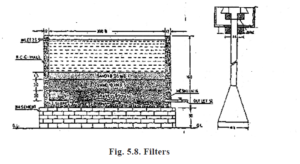
a) Mechanical filter b) Airlift filter.
The sand is supported on two or three layers of graded gravel, with the finest layer immediately below the sand and the coarsest material at the bottom of the filter, packed around the drains. The gravel layers must be graded sufficient to prevent the material from mixing and the sand being drawn down.
The following thickness may be taken for the filtering materials from the bottom towards the top.
1. 10 cm to 15 cm of broken stone 40 mm to 65 mm size
2. 8 cm to 15 cm of gravel 20 mm to 40 mm size
3. 5 cm to 10 cm of gravel 3 mm to 6 mm size
4. 15 cm of coarse sand and
5. 60 cm to 90 cm of fairly uniform fine sand.
When the resistance in the filter (due to sand and clogging) i.e., loss of head, is equal to the total depth of water on the filter, the operation will stop. The loss of head should not be greater than the depth of the filtering sand. When it becomes excessive and before a negative head is formed the filter should be cleaned. The level of the filtered water at the outlet chamber should not be below the level of the surface of the filter sand.
The rate of filtration is 120 litre per minute when the graded layers are 1′ sand of 0.05 to 0.1 mm, 6″ sand of 0.1 to 0.5 mm, 6″ gravel 2 to 5 mm and 1′ metal 5 to 10 mm at the total filtering surface area of 144 square feet.
biologi aku saringan R
It comprises the mineralisation of organic nitrogenous compounds, nitrification and dentrification by bacteria suspended in the water and attached to the gravel in the filter bed.
Heterotrophic and autotrophic bacteria are the major groups present in culture systems. Heterotrophic species utilize organic nitrogenous compounds excreted by the animals as energy sources and convert them into simple compounds, such as ammonia. The mineralisation of these organics is the first stage in biological filtration. It is accomplished in two steps; ammonification, which is the chemical breakdown of proteins and nucleic acids producing amino acids, and organic nitrogenous base and deamination in which a portion of organics and some of the products of ammonification are converted to inorganic compounds.
Once organics have been mineralised by heterotrophs, biological filtration shifts to the second stage which is nitrification, it is the biological oxidation of ammonia to nitrite and then to nitrate by autotrophic bacteria. Those organisms unlike heterotrophs require an inorganic substrate as energy source and utilise carbondioxide as their only source of carbon. nitrosomonas dan bakteri nitro sp. are the principal nitrifying bacteria in culture systems. nitrosomonas oxidises ammonia to nitrite, bakteri nitro oxidises nitrite to nitrate.
The third and last stage in biological filtration is dentrification. This process is a biological reduction of nitrate to nitrite to either nitrous oxide or free nitrogen. Dentrification can apparently be carried out by both heterotrophic and autotrophic bacteria.
A Saya R aku jika T menyaring e R
It is the most trouble free means of filtering water through synthetic sponge layer by pumping the water with air lift (fig 5.8b). In culture applications, lift pipe extends below water level and the filter chamber rests above the top water surface. The suspended or colloidal impurities upto the size of 0.002 mm can be filtered out through this system. By pumping 5 cm3 air /sec/. 2 litres of water per minute can be filtered when the diameter of the lift pipe is 1 cm.
S um M ar kamu
Fish culture is practised in ponds. These are small shallow bodies of water in natural conditions and completely drainable, usually constructed artificially.The natural ponds differ from the lakes in having a relatively large littoral zone and a small profundal zone. Their source of water may also vary.
Nursery ponds are also called transplantation ponds. These are seasonal ponds and are constructed near the spawning and rearing ponds. The main object is to create a suitable condition of food availability and growth of fry because at this stage they are most susceptible to hazards like the wave action and predators. These should be small and shallow ponds 0.02-0.06 ha. in size and 1-1.5 m. secara mendalam. In the nurseries, the spawn (5-6 mm) are reared to fry stage (25-30 mm) for about 15 days. These ponds are usually rectangular in size. Extra care should taken for rearing the young stages, otherwise heavy mortality may occur. Sometimes the spawn are cultured for 30 days also. The pond bottom should gently slope towards the outlet to facilitate easy netting operations. Small and seasonal nurseries are preferred as they help in effective control of the environmental conditions. In practice about 10 million spawn per hectare are stocked in nursery ponds.
Rearing ponds should be slightly larger but not proportionally deep. These should be located near the nursery pond and their number may vary depending upon culture. They should preferably be 0.08-0.10 ha in size and 1.5-2.0 m in depth. The fry (25-30 mm) are reared here upto the fingerling (100-150 mm) stage for about 3-4 months. Carp fry grown in nursery ponds are relatively small in size and not fit enough for their direct transfer into stocking ponds. In stocking ponds bigger fishes are likely to be present which may prey upon the fry. Karenanya, it is desirable to grow the fry in rearing ponds under proper management practices upto fingerling size so that their ability to resist predation will be improved.
Stocking ponds are the largest ponds and are more deep, with a depth of about 2-2.5 m. The size of the pond may vary from 0.2-2.0 ha., but these should preferably be 0.4-0.5 ha in size. These are rectangular in shape. The fingerlings and advance fingerlings are reared upto marketable size for about 6 months. One year old fishes may grow upto 1 kg. or more in weight.
The pond management consists of pre-stocking, stocking and post stocking management phases.
Pre-stocking pond management involves site selection, eradication of weeds, insects and predators, liming, manuring, dll.
Post-stocking pond management involves water quality management, feed and health management and harvesting.
Based on the intensity of infestation and type of weeds, the aquatic weeds can be controlled by means of manual, metode kimia dan biologi.









